When early and new music intersect, alliances are opening up a sense of fresh potential for both sides
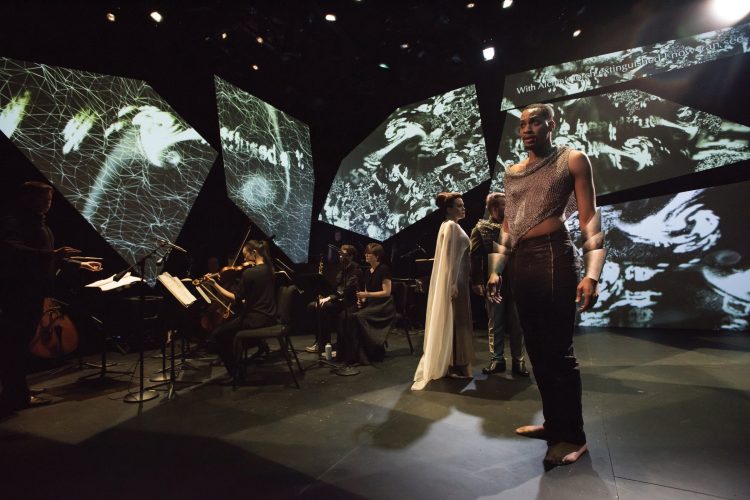
from the September 2018 issue of EMAg
The early-music movement’s successes have a way of being remarkably rejuvenating. In the hands of its exponents, instruments and performance practices long assumed to be “obsolete” transcend the era that produced them and still speak to audiences today. A conviction once regarded as far-fetched has thus come to seem like common sense. Not so obvious is the extent to which period instruments and styles might be relevant for living composers—or the latter a promising new source for musicians who usually look to the archives to expand their repertoire.
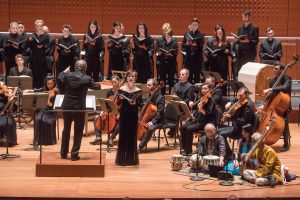
“Composers are discovering that early instruments are an appealing tool to work with. And the people who play them are eager to engage with them,” says Robert Mealy, the admired baroque violinist who heads the Historical Performance program at the Juilliard School. Thanks to his academic positions—he’s also on the faculty at Yale—Mealy has his finger on the pulse of a new generation of composers and performers who are putting this mutual interest to the test.
“At a time when there is no overarching narrative for composers, they feel at liberty to explore all kinds of directions in their work,” Mealy says. He’s been actively working to foster these connections in ongoing collaborations involving Juilliard’s period-instrument ensemble, Juilliard415, the Yale Schola Cantorum, and a new generation of composers. In 2017, under the baton of David Hill,the two groups presented This Love Between Us: Prayers for Unity, a substantial oratorio they co-commissioned from Indian-American composer Reena Esmail and took on a tour to India. Setting texts in eight languages from India’s tapestry of sacred traditions, Esmail incorporated Indian instruments (sitar and tabla) into her scoring for choir and baroque orchestra.
When the collaboration with composers calls for a response to an existing classic, the results can be no less unpredictable. For spring 2019, for example, Juilliard415 has commissioned seven composers to create responses to Haydn’s The Seven Last Words of Christ. “We don’t know what will happen yet,” says Mealy. “What I hope is that it will be seven different responses. The challenge is always to find composers who will celebrate the virtues of these instruments, their physicality. The pleasure of that physicality is what brought so many of us into HIP in the first place. I do a good deal of background work to explain the possibilities.”
From the musicians’ perspective, this zeal to make composers aware of the potential they have to offer is the driver for a thriving scene of commissions by HIP ensembles that have emerged in recent years, such as New Vintage Baroque, founded by oboist Lindsay McIntosh (a graduate of Juilliard’s Historical Performance program), and Boston-based Antico/Moderno. Their efforts have taken the early-new music alliance outside the setting of academia, showing that there is a marketable interest in such projects.
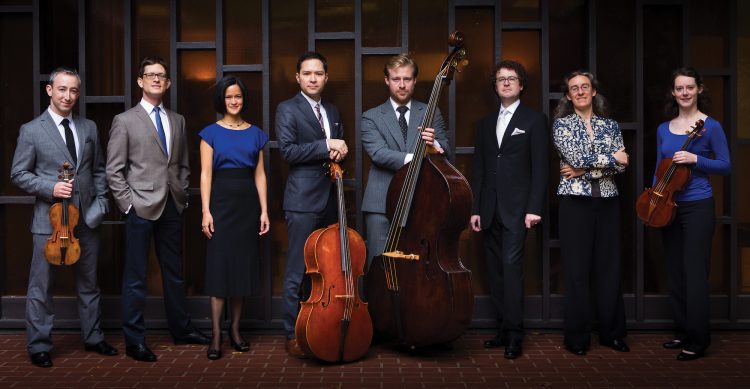
“When I first started learning early-music performance practice, I had this strange feeling that it was similar to what I experienced when facing a new piece of music,” says Jacques Lee Wood, a cellist and former student of Mealy at Yale. “Both gave me a sense of liberation.” From that was born the idea for Antico/Moderno, which Wood co-founded in 2014 with a fellow Yale graduate, composer, harpsichordist, and organist Bálint Karosi.
But Wood discovered that asking composers to write for their period-instrument ensemble “turned out to be a much harder task than we had expected, because we were finding that composers weren’t necessarily at all fluent in that language.” So Antico/Moderno developed a series of workshops and mini-residencies to offer composers a deeper background. “We wanted to get them to think about more than the devices and to be aware of the different aesthetics as well, such as ornamentation and improvisation, or using a variety of unequal tunings as a compositional tool.”
One of the first pieces that encapsulated what Wood and colleagues were looking for was Katherine Balch’s Recordatorio, a brief but eloquent work written for contralto Hilary Summers and trio-sonata accompaniment that sets a Latin excerpt from Ecclesiastes. “It’s about remembering or misremembering things from the past and collective forgetfulness,” says Balch. She discovered that this encounter with instruments and styles of the past resonated with her own aesthetic. “I find the quality of sound of gut strings attractive, since a lot of my music has to do with overtones.” Another reason for the interest in such collaborations, Balch suggests, is the background in improvisation that is second nature to HIP musicians. “That allows for a collaborative environment that is more conducive to exploring sound.”
Since co-founding Antico/Moderno with Wood, Karosi has continued to carry out its mission in his work directing the music program at Saint Peter’s Church in midtown Manhattan. A native of Hungary, Karosi himself writes for period instruments but infuses the patterns he finds in the 18th-century masters who serve as models—above all, J.S. Bach—with a contemporary sensibility in order to come up with something new. “I approach my compositions with an awareness of these early-music schemes such as tonal relationships, cadences, and sequences so prevalent, key relationships, but my schemes are totally different. My Hungarian background and American Minimalism are a big influence, along with unusual time signatures.”
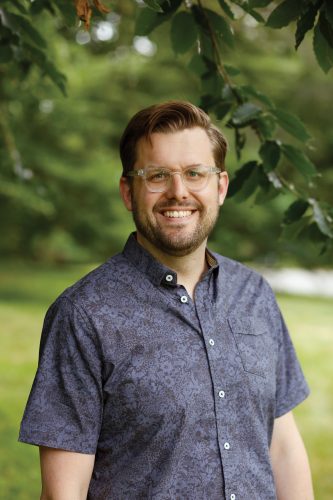
For his Night Scenes from the Ospedale, Robert Honstein drew on both period instruments and a familiar Baroque model to imagine something unmistakably contemporary. He was asked by the New York-based ensemble The Sebastians to write a set of pieces to accompany concerti from Vivaldi’s L’estro armonico. “It’s a theatrical programmatic concept whereby my pieces depict nighttime episodes at the orphanage for girls, while the concertos Vivaldi wrote for them represent daytime episodes,” Honstein says. “I became interested in the possibilities of using contemporary effects like scraping and scratchy sounds on these period instruments because they speak in such a clear way, creating soundscape environments that are very evocative and rich.”
Night Scenes marked Honstein’s first foray into writing specifically for period instruments and is characteristic of the kind of cross-pollination between early and new music that artists are increasingly seeking out. There have been harbingers of this development, such as the oratorio-esque theater piece Lost Objects (2001), a collaboration between new music mavericks Bang on a Can and Concerto Köln (along with DJ Spooky). But the past two decades have witnessed a sea change, according to Doug Balliett, a prolific composer, bassist, and period-performance specialist who also teaches at Juilliard.
“This generation of students has been told you don’t have to choose to stick to one field,” he says. “There’s been a lot of fracturing and a breakdown of taboos. Early music becomes one option on the menu, and it’s one I really love.” Balliett effortlessly ranges across a vast spectrum—one of his calling cards is a series of rap cantatas based on Ovid’s Metamorphoses—but at the same time he places a high value on tradition. “An important distinction I have learned is that when you compose for a baroque violin, you are really composing for a baroque violinist. You’ve got to consider the training and the world that this person is originating from. You really should seek advice. I want the experience of these players who are trained and have this specialized skill to improvise.”
The baroque bassoonist and producer Clay Zeller-Townson, who founded the innovative baroque band Ruckus, reaffirms the importance of this sort of education. He has worked extensively as a “liaison” between composers and these instruments. “The challenge is to develop a deep connection between the instruments that we are using and the contemporary language,” he says. “Otherwise, it can quickly feel like a gimmick. For the composer to get used to the function of these instruments and their unique constraints takes a lot of time.”
The collaboration should not resemble simply trying on a different outfit for a quick new look if the intent is to create something meaningful, insists Zeller-Townson. And the performers bring to the encounter a rich layering of experiences. “We are making something new that engages with the past. Along with the early performance styles and textures we let ourselves experiment with—with all the elements of drama and character and affect they involve—we’re also pulling from our own lives as composers or arrangers who are open to folk traditions, jazz, or other textures that might not be part of the usual language of early-music performance.”
While period-instrument ensembles are increasingly on the lookout for good matches with contemporary composers, Jonathan Dawe recalls the dearth of such initiatives when he was emerging as a composer. “I’ve always had a fascination for early music, but back in the 1990s it wasn’t in the interest of a lot of the more established groups to engage with modern music.” Dawe has carved out a niche by subjecting small fragments of Baroque music to techniques based on fractal geometry—an approach that has been labeled “fractal Baroque”—in such works as the 2010 chamber opera-ballet Cracked Orlando: dramma per musica e fractals.
As a student of Milton Babbitt at Juilliard, where he now teaches, Dawe says his mentor found his shift from the Modernism typical of the era to his fractal method “far more interesting than the generic Boulezian stuff I’d been writing, because you can hear how I transform Baroque rhetorical devices like those that Handel would use.”
Cracked Orlando combines modern and historical instruments. Dawe finds the redirection of instruments and affects that were calculated for earlier eras to decisively modern uses to be fascinating, particularly in how an audience reacts to “deep intrinsic references to other types and times of music. Some people find it compelling, while others experience it as ironic, sarcastic, or even comical. But when it works, there’s a real directness and a sense of isolating particular emotional states that can be powerful.”
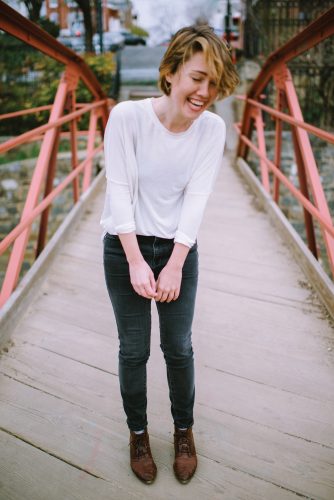
The Pulitzer Prize-winning composer Caroline Shaw started out as a violinist playing Baroque and Renaissance music and is also a singer with the ensemble Roomful of Teeth. Rather than a temporarily adopted style, the early-music aesthetic is “an organic part of what I write as a composer,” she says. “I have this affinity for the open sonorities of early music and for its connections to dance.” She points to the “non-vibrato style of singing, which favors a certain clarity of pitch and resonance. It actually comes closer to a modern aesthetic than the 19th-century choral sound.”
Gregory Spears is another young composer who naturally incorporates an early-music sensibility into his work alongside impulses from new music: “My way of entry was through the voice. I became intrigued by the connection between early-music singing technique and my love of Minimalist composers, especially Steve Reich and his use of voices without vibrato. The singing voice is the default of instruments like a baroque violin.”
Spears has composed specifically for period-instrument ensembles in such works as the dramatic cantata Virginiana and the in-progress dance-opera project Wolf-in-Skins, a collaboration with choreographer/librettist Christopher Williams and countertenor Anthony Roth Costanzo. But even when using modern instruments as in his acclaimed opera Fellow Travelers (“with lots of metal in the pit”), he inclines toward a vocal style clearly informed by an abiding love for Handel, with a melismatic quality that becomes hauntingly poignant in its modern context.
“My sensibility is already influenced by working with period instruments,” Spears says. “It has to do with wanting to hear a certain ring in the orchestration. And I’ve been very intrigued not just with early instruments but with early-music players and the way they think about music and approach scores.” In other words, the attraction goes beyond issues of timbre. “What’s important for me is that this is never divorced from all the musical training and the musical-historical elements that come along with those instruments: for example, the very radical way time works in a Handel opera.”
All of the examples discussed until now have featured composers and performers based on the East Coast—primarily in New York or Boston. But Nicholas McGegan and his Philharmonia Baroque Orchestra have made the Bay Area into a hotbed for similar efforts, starting with a one-act opera PBO commissioned Jake Heggie to write in 2006: To Hell and Back, a take on the Persephone myth using period-instrument forces.
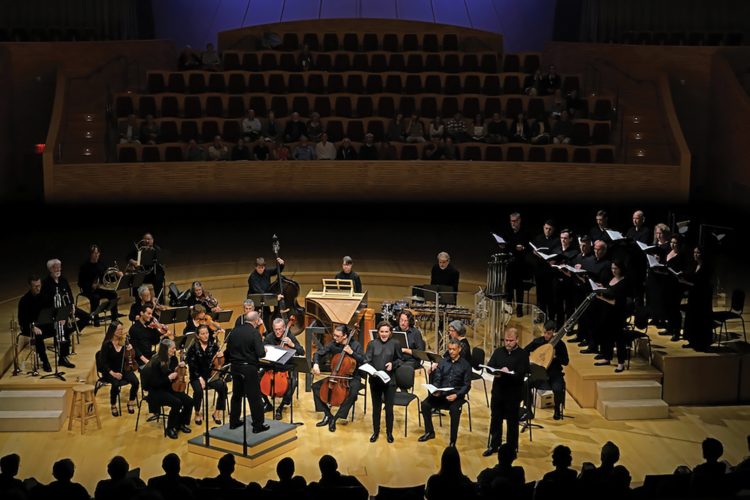
“It delights me that so many in the younger generation have never experienced that terrible divide between old and new orchestras,” says McGegan. “What we are offering is a different sound world which is equally valid.” The composer is not the only party to benefit. “A challenge to an orchestra and a chorus is a good thing. If you don’t challenge a period-instrument orchestra, it dies artistically. My job is to keep people on the edge of their seats—the players and the audience.”
At the same time, McGegan points out that commissioned works entail “some quite definite parameters. One is that I know the composer personally and one is that the composer works with us and attends as many rehearsals as possible.” To that end, he has launched the “New Music for Old Instruments” initiative. Its most recent effort is The Judas Passion by Scottish composer Sally Beamish, which PBO co-commissioned with the Orchestra of the Age of Enlightenment, giving the American premiere in 2017.
Beamish, who had little previous experience writing for period instruments, found it valuable to spend time with the musicians to learn about the technical possibilities. “For example, there are things you can do with a baroque flute which you can’t with a modern flute—types of glissando and sound production by sliding between notes,” she says. “The horns and trumpets were very complex to learn. I used all the possible crooks and found I could cover chromatic lines by fading the two horns into each other.”
These and other discoveries opened up a palette of sonorities Beamish says she never would have thought of otherwise. “It has made me think in a different way, which I did out of necessity. I expect I’ll be influenced in other works by having used the period instruments.”
McGegan has commissioned future works for PBO from Shaw—whose music has already been featured in the series—and composer-conductor Matthew Aucoin, artist in residence at Los Angeles Opera. Aucoin plans to compose two cantatas to the poetry of Holocaust survivor Paul Celan that will be paired with Bach cantatas. “Celan’s heroic effort to find holiness in this wrecked universe reminded me of Bach cantatas in their intensity,” says Aucoin. The project will also involve a staging with his ensemble, the American Modern Opera Company.
Like an increasing number of composers of his generation, Aucoin finds the impulse to bridge the worlds of early and new music completely natural. “I think they are closer in spirit than to the mainstream orchestral world because in both cases you have many smaller-scale groups and artists who tend to be early self-starters. They recognize that they don’t fit into a box and decide they will start to build one themselves.”
Aucoin does anticipate that his harmonically dense musical style will pose challenges because of the early instruments’ technical limitations. At the same time, “I think it will be an extension of my current musical thinking. I’m a gatherer. There are elements of Berg, jazz, Minimalism, and so many other things, but at its heart my music is lyrical and ecstatic.”
As Antico/Moderno’s Wood points out, the convergence of new and early music is about a great deal more than the appeal of new sonorities and timbres: it extends to the possibilities of a different system of aesthetic values. These can have astonishingly powerful results for composers who approach period instruments from widely varied perspectives.
And still another attraction, according to Mealy: “Composers who work with period-instrument ensembles like the level of care and attention that is part of our working process. This is a very detail-oriented culture, where musicians want to make individual gestures as vivid as possible.”
Thomas May is a writer, critic, educator, and translator. He is the English-language editor for the Lucerne Festival and contributes to the New York Times, Seattle Times, Musical America, and many other publications. He also blogs about the arts at www.memeteria.com.

